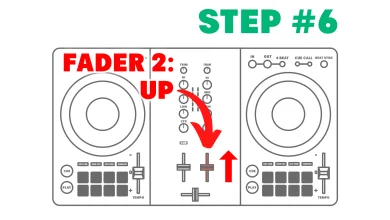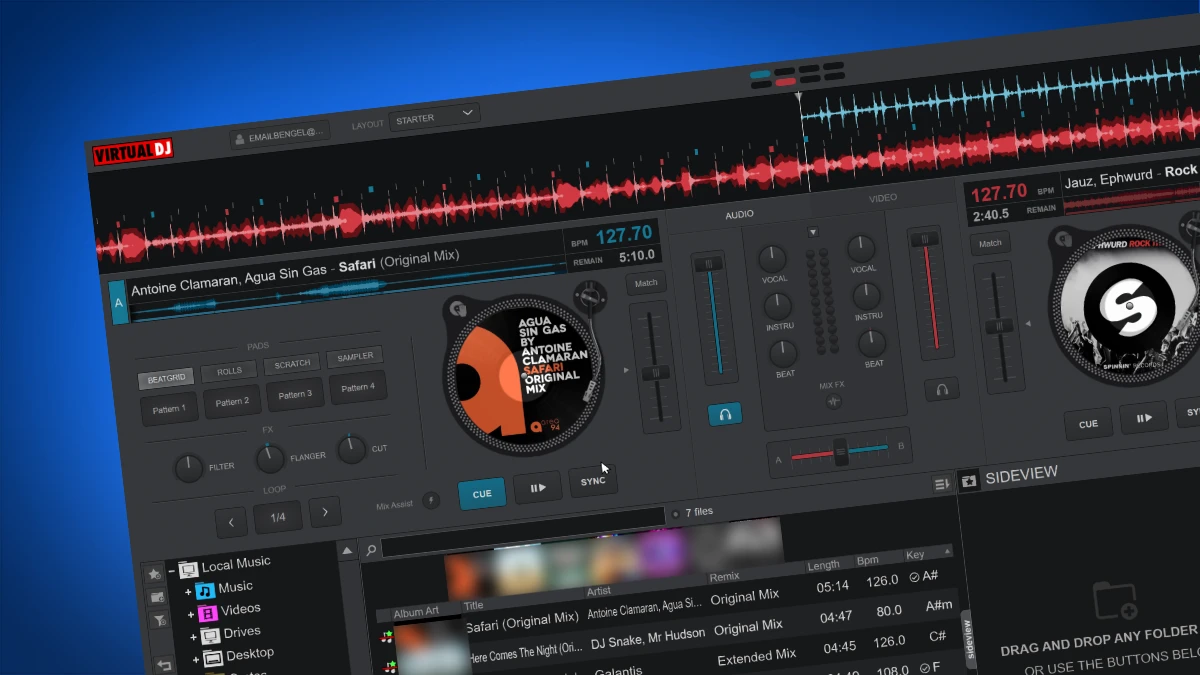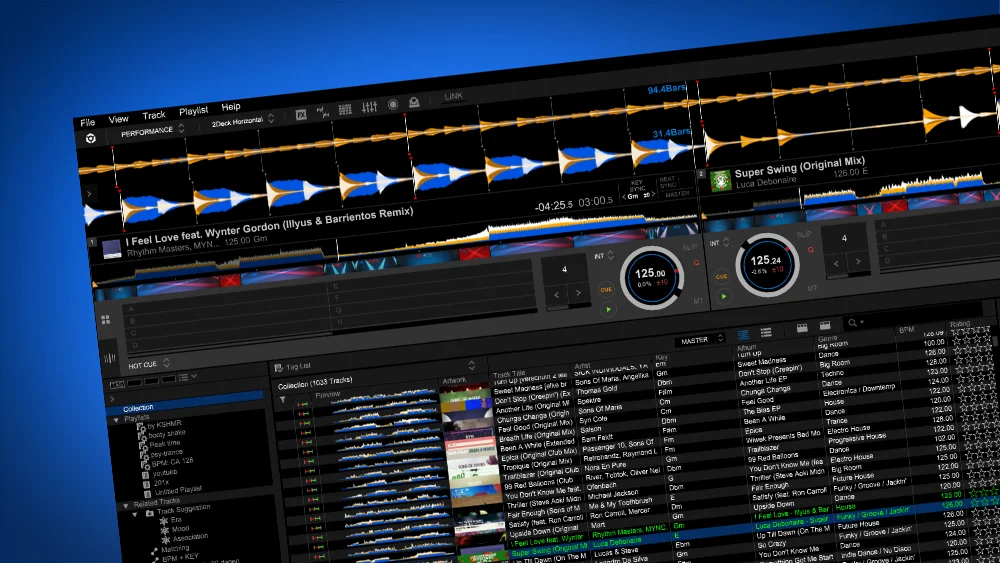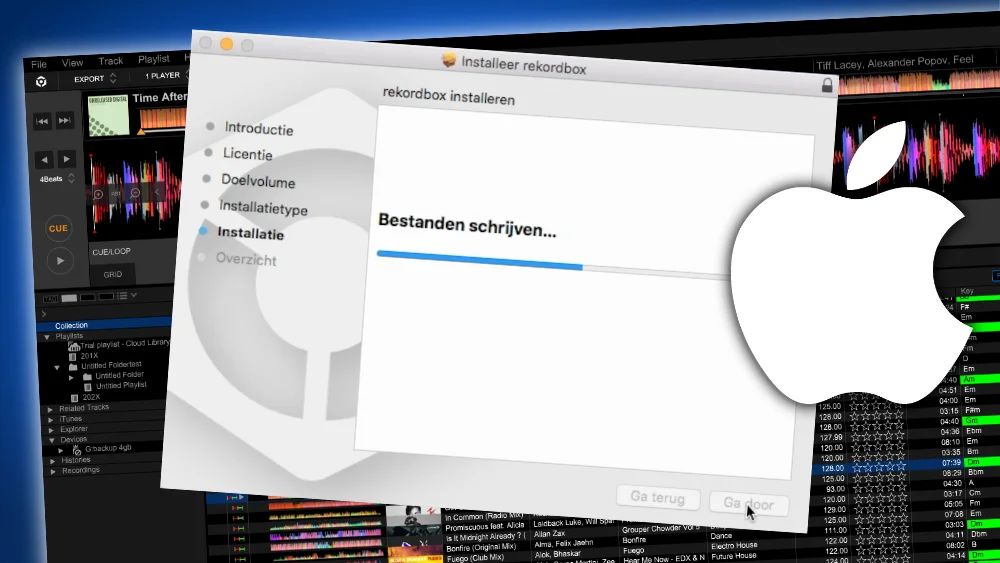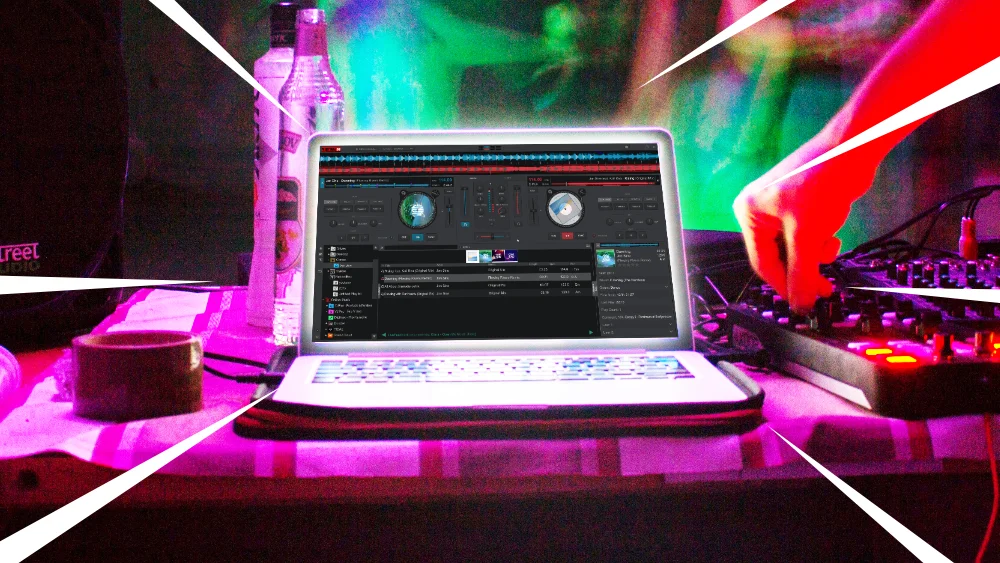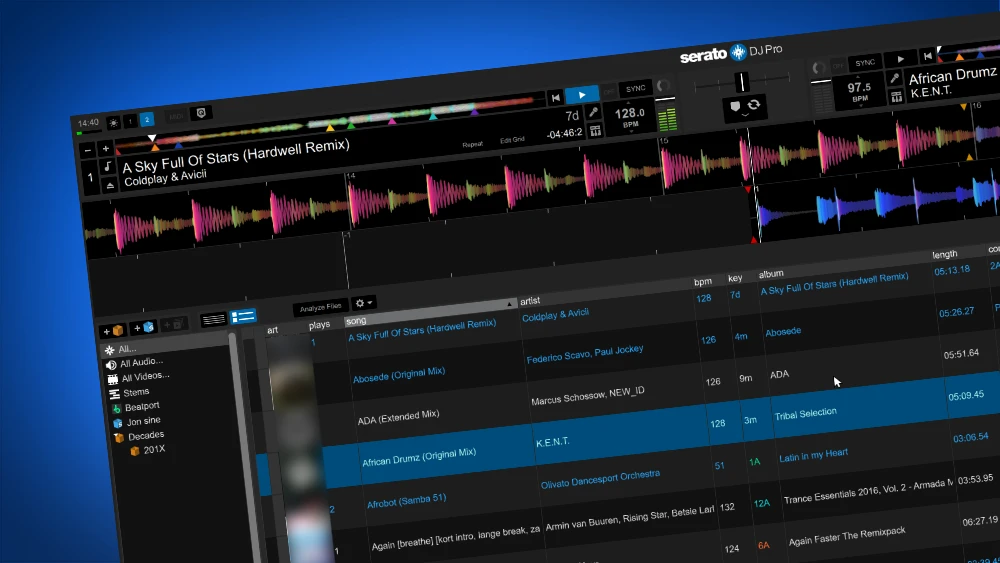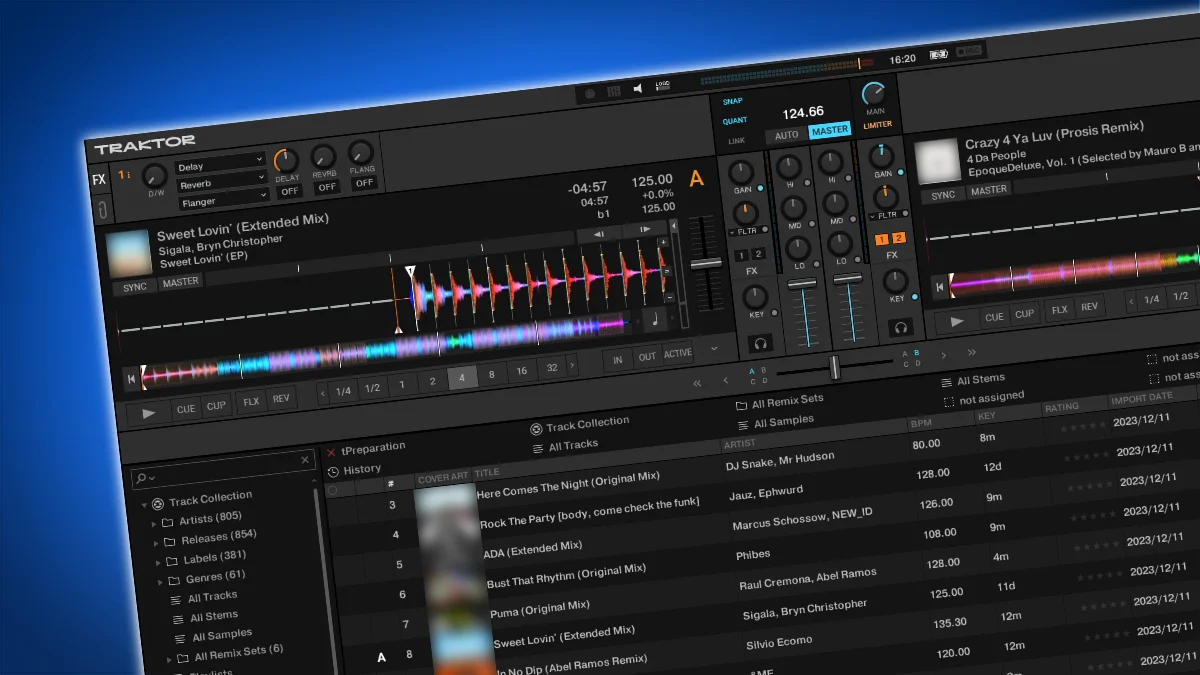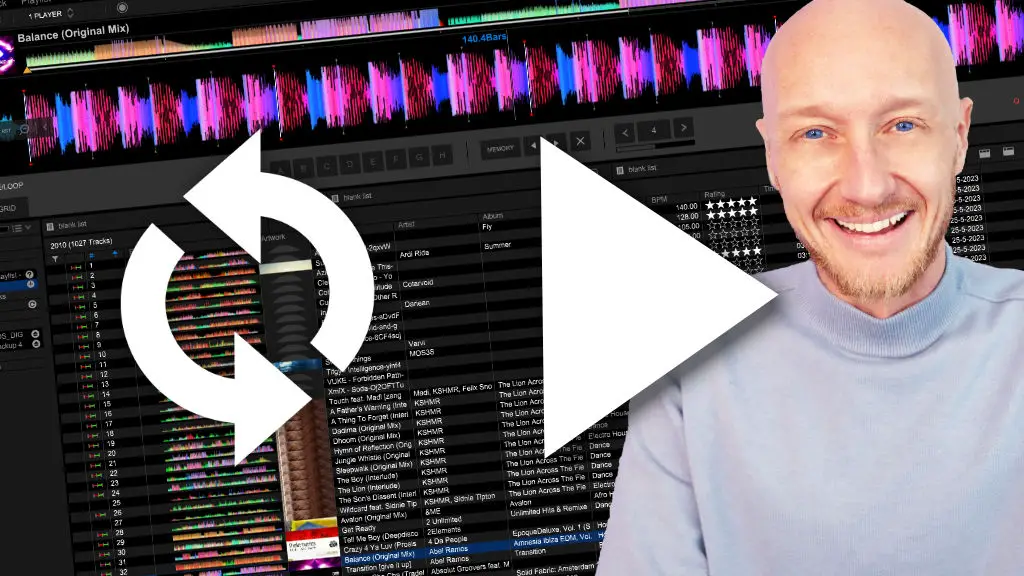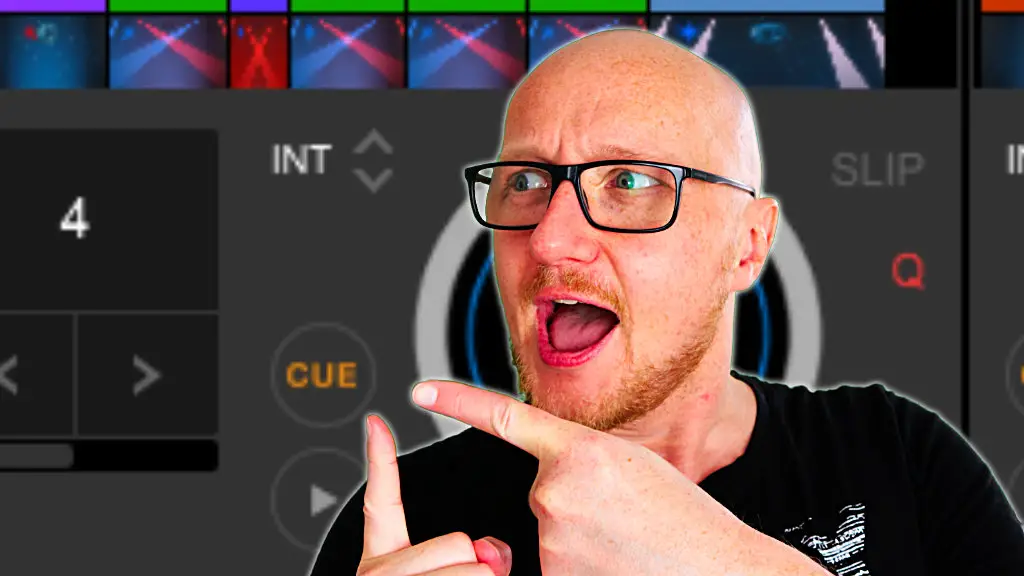1427 DJs voted: Best DJ software 2026 – tested & reviewed
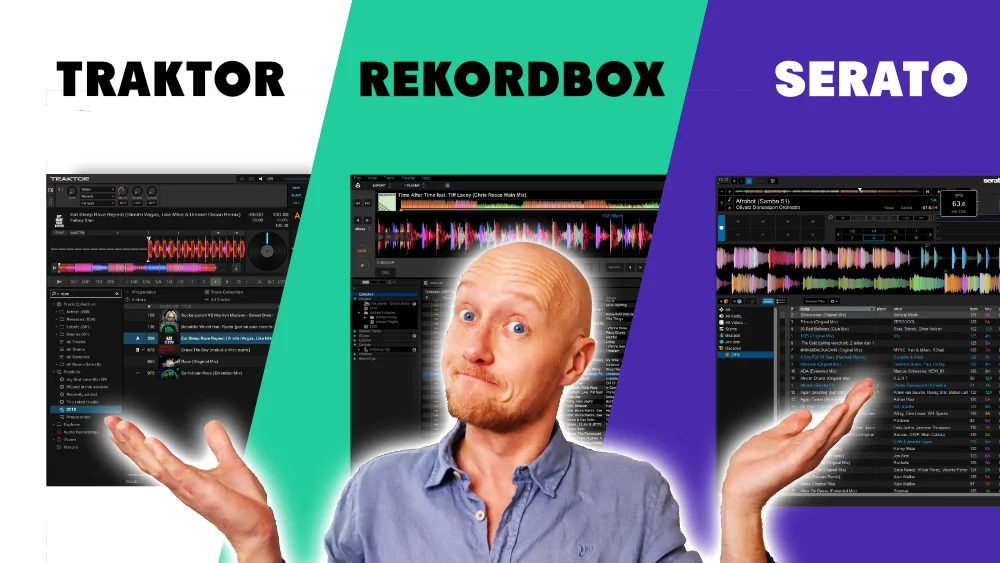
For this article I have installed ALL DJ software on the market on my computer and tested each and every one, so I could give you my honest opinion about all of them.
I polled my audience for the top 4 DJ software.
The results of the poll you can find later in the article.
I added the rest of the software for completeness sake, and ranked 5-8 myself.
I’ve created a feature comparison table for ALL DJ software.
And I’ve tested performance of all software and created handy performance comparison table for you.
Both you can find at the bottom of this article.
Table of Contents
- #8. Beatport DJ
- #7. Mixxx
- #6. DJuced
- #5. DJay Pro
- #4. Traktor
- #3. Virtual DJ
- #2. Serato DJ
- #1. Rekordbox
- Honorable mentions
- Best DJ software for beginners
- Features compared
- Performance compared
- Poll results
- Video
- Relevant reviews
#8. Beatport DJ
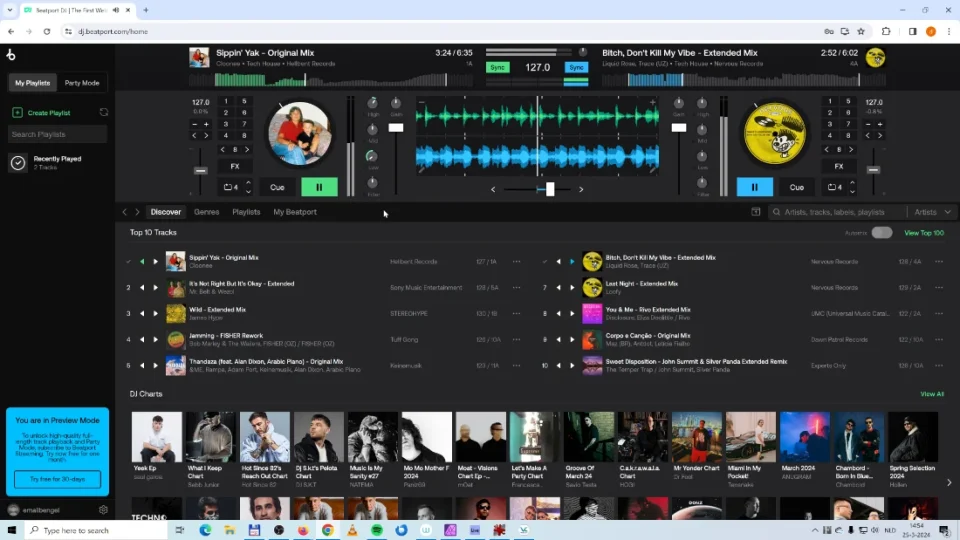
Beatport DJ is a webapp by Beatport.com.
The app is great if you want to see if 2 beatport mix well together, much not-so-much for real DJing.
The app is laggy and often unresponsive, especially with a controller.
Timing is everything with DJing, lag does not help.
The app has some limitations, most notably:
- You can’t nudge a track forwards or backwards, even with a controller, you can only beatmatch with tempo slider.
- You can’t use your own tracks, only Beatport’s.
- Spotty DJ controller support (not a lot of controllers are supported fully)
- The waveform is monochrome and very coarse (I miss details)
- Visual representation of a loop in a waveform is not clear
- I miss Smart lists.
- I miss a Key lock or transpose feature
- I miss being able to search for compatible tracks based on key and tempo would be useful.
- I miss a Slip mode. I couldn’t find it. I hardly use it, so not a deal breaker in my book.
- I miss Beat jump. Would be nice to be able to correct a mistake.
Just consider any of the other software that I mention on this page, some are even free.
Read the full review on Beatport DJ (warning: it isn’t pretty).
Price: $10 a month
Manufacturer: Beatport
Website: dj.beatport.com
Try demo: dj.beatport.com
Personal rating: ⭐
| Pros | Cons |
| ✔️ Collab with other DJs | ❌ Unresponsive/Laggy / latency |
| ✔️ Camelot Key notation | ❌ Missing too many features |
| ✔️ FX pad is pretty interesting | ❌ Limited controller support |
| ❌ Flickering buttons | |
| ❌ Only on Chrome | |
| ❌ Can’t import songs | |
| ❌ Spacebar scrolls tracks | |
| ❌ limited sound card support | |
| ❌ making loops is not clear | |
| ❌ coarse waveform | |
| ❌ can’t nudge track | |
| ❌ need internet connection | |
| ❌ can’t edit beatgrid | |
| ❌ can’t disable quantization | |
| ❌ license only with subscription |
#7. Mixxx
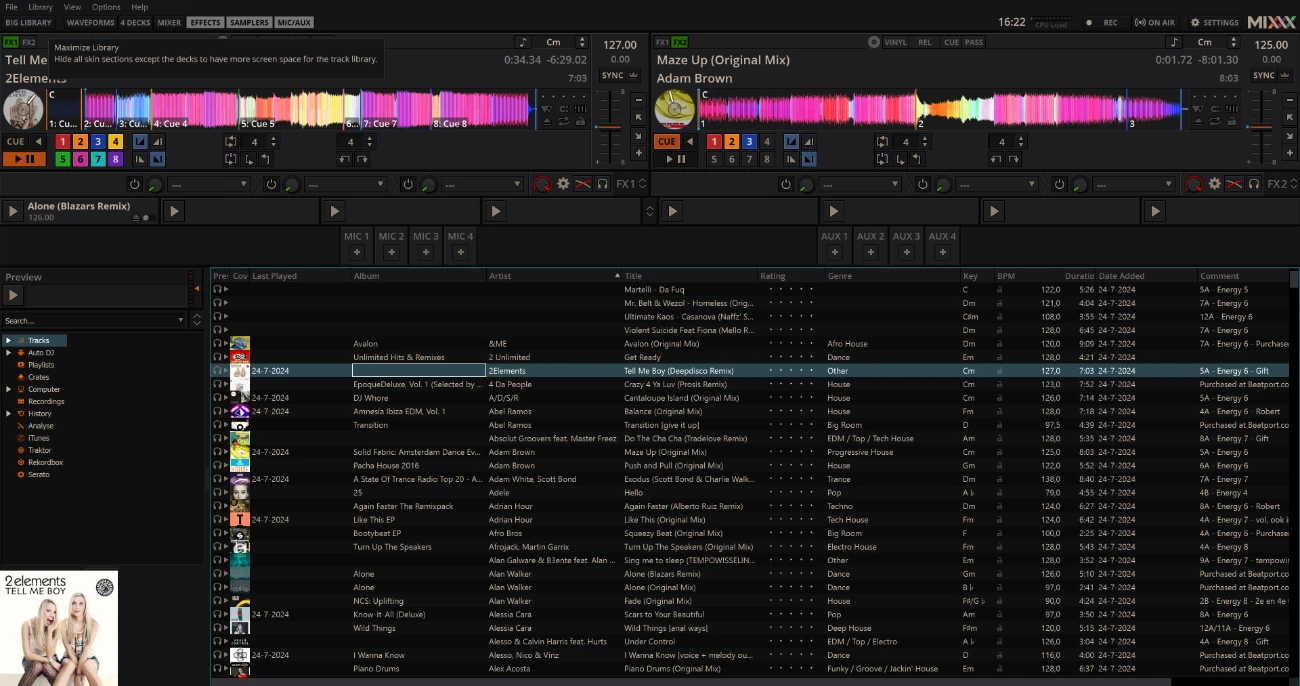
Mixxx is the only true free software in this list.
It is open source and available on Mac, Windows and even linux.
The software is actually quite good for open source software.
Most open source software is clunky and doesn’t operate the way you’d expect.
Which is the case here and there in the software:
- The controller support is clunky, although really flexible. Mixxx can learn your own MIDI controller
- When analyzing music, the software seems “frozen”
- The metronome to correct the beatgrid is an effect you have to load in
The main complaint I have with the software is the inaccuracy of the the beatgrid.
It is off slightly for every single track:

Some tracks are completely off-grid.
This happens quite regularly.
Some features are missing:
- Auto stem separation
- Cloud storage support like Dropbox or Google Drive
- Support for steaming services like Beatport or Beatsource
The software has a second focus on radio DJs.
For example: you can stream your set to Icecast and Shoutcast
For free software it is really good.
But comparing it to other software when it comes to usability and beatgrid accuracy, other software is better.
Price: $0
Manufacturer: Volunteers
Website: https://mixxx.org/
Download: https://mixxx.org/download/
Personal rating: ⭐⭐⭐
| Pros | Cons |
| ✔️ Free | ❌ Inaccurate music analysis |
| ✔️ Looks good | ❌ No streaming music |
| ✔️ Extensive controller support | ❌ No cloud storage |
| ✔️ Hot cues automatically set | ❌ No auto stem separation |
| ❌ Small buttons | |
| ❌ Sometimes clunky |
Free DJ tips in your inbox?
As a bonus gift I will send you a FREE E-book on how to kick-off your DJ career!
#6. DJuced
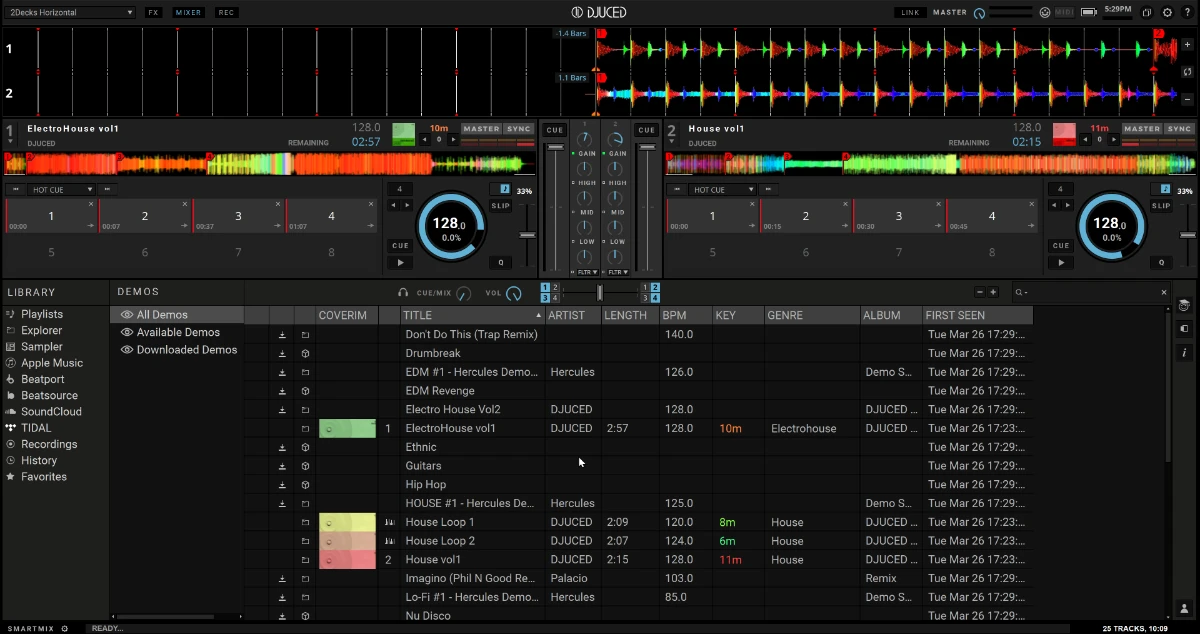
DJuced is the DJ application that is bundled with Hercules controllers, thus doesn’t support other controllers.
There are 2 versions of the software: a version with controller, and a version without controller.
Both versions are free.
The version with controller could handle 4 decks (instead of 2) and has the ability to record.
What I like about the software is the red flashing of the waveform to alert the DJ that a track is ending.
The user Interface is pretty straightforward and uncluttered, although the PLAY and CUE buttons could be bigger.
The feature set of the software is pretty much complete, especially for the beginner.
But there are some serious issues with the software:
- The beatgrid is often wrong. Not “sometimes“, but “often“
- I had regular crashes when grabbing the waveform with the mouse
- The stem separation sounds really bad
Price: $0 (with or without controller)
Manufacturer: Guillemot Corporation / Hercules
Website: djuced.com
Download: djuced.com/downloaddjuced/
Personal rating: ⭐⭐⭐
| Pros | Cons |
| ✔️ Free | ❌ Crashes |
| ✔️ Simplicity | ❌ Beatgrid often wrong |
| ✔️ Mixcloud support | ❌ Lacks eye candy |
| ✔️ End-of-track flashing | ❌ Only Hercules controllers |
| ✔️ Included demo tracks | ❌ No nudging track |
| ❌ Only Open Key | |
| ❌ No Dropbox support | |
| ❌ Stem separation not good |
#5. DJay Pro
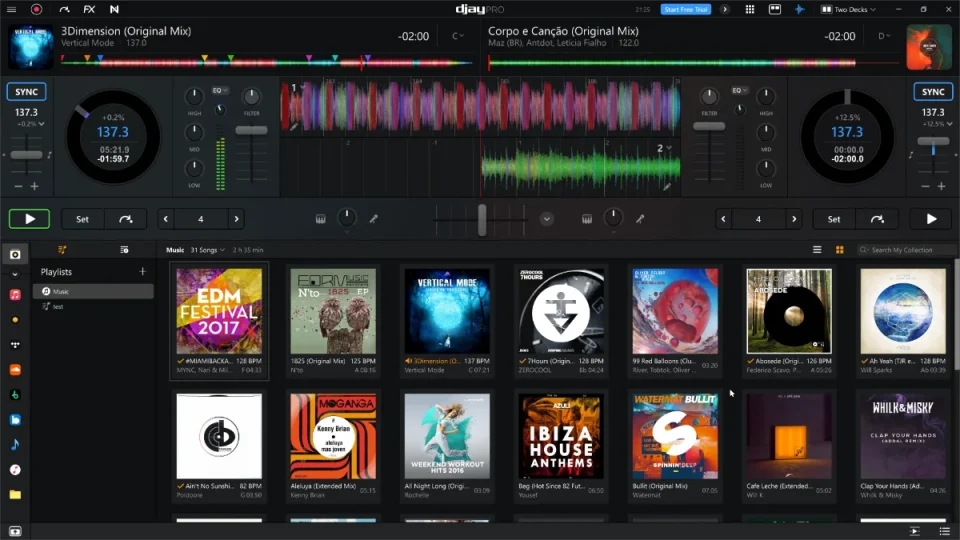
DJay Pro has a very clean and responsive User Interface.
Big buttons for easy navigation and no stuff in the way you don’t need.
DJay Pro is one of those software programs that get it.
The audio manipulation algorithms to time-stretch and key-lock are very good.
Also the stem separation of existing tracks is among the best I’ve heard in DJ software.
Regretfully you can’t import your whole library in one big batch, you have to drag tracks per 100 or so in the software.
On top of that, it doesn’t analyze tracks for key and tempo on import, you have to do that manually, which is annoying.
But it does analyze a song once you use it in one of the decks.
It does set Hot Cues automatically, which is an absolute time saver.
I do miss some features, most notably:
- Smart lists. That’s a feature I really miss.
- Slip mode. I couldn’t find it. The iPad version has it.
I hardly use it, so not a deal breaker in my book - Beat jump. Would be nice to have to correct a mistake. The iPad version has it.
- Search for compatible tracks based on key and tempo is something that I miss.
I really like the software, my biggest beef with the software is: Algoriddim only offers a license in the form of a subscription.
Price: $50 per year
Manufacturer: Algoriddim
Website: algoriddim.com
Download: Mac App Store, iOS App Store, Microsoft Store, Android Play Store
Personal rating: ⭐⭐⭐⭐⭐
| Pros | Cons |
| ✔️ Responsive | ❌ Subscription |
| ✔️ Uncluttered UI | ❌ No track suggestions |
| ✔️ User friendly | ❌ No Cue button |
| ✔️ Automix feature | ❌ Options screen |
| ✔️ Sound quality algos | ❌ No dropbox support |
| ❌ Import = weird | |
| ❌ No smart lists |
#4. Traktor
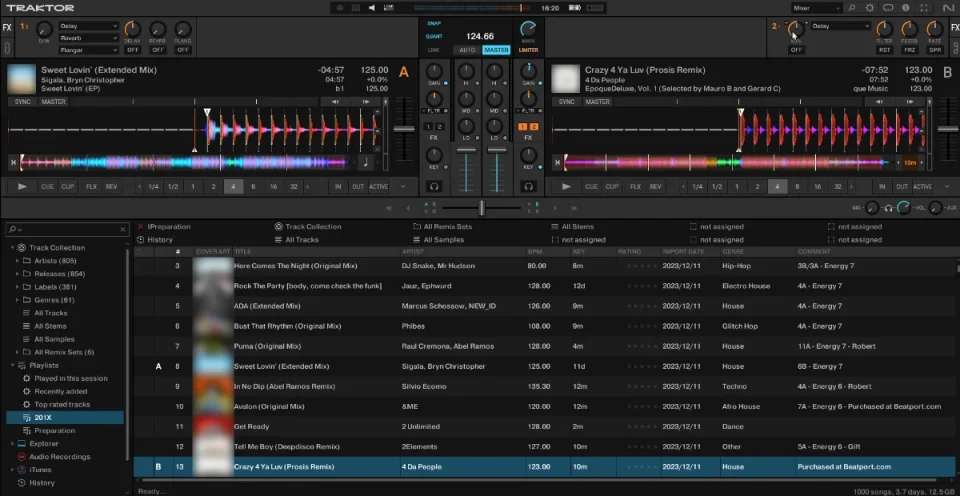
The User interface of Traktor is nice and clean, with big buttons for easy clickability.
Traktor has an extremely customizable interface, but not in a good way.
There are tons of deck types (menu), views (menu), deck-type-views (double-click) and a space bar view, which all change the look of the software.
The CUE button for example isn’t displayed in every view (or was it deck-type? or deck-type-view? … I can’t remember…)
When you first start the software there are 100 questions of which I don’t know how to answer them.
After that, an overcrowded settings screen shoved in your face.
It all feels very intimidating for a first-time user.
Traktor is super light on system resources, which I see as a big thumbs up.
However analyzing the music is one of the slowest of all software I mention in this article.
The software doesn’t support stem separation of existing tracks, but it supports playing stem-tracks.
Which is a feature I don’t see very often in DJ software.
I see this as a positive thing, because the audio quality of all auto-stem-separation in pretty much all DJ software sucks.
Another thing I noticed is that Traktor uses the Open Key Notation (C-Min = 1D) instead of the Camelot notation (C-Min = 8B).
It’s not an impossible hurdle to overcome, because it works basically the same as Camelot, but things are named differently.
I really like the software, and would recommend it for existing DJs.
For beginners, I would look at something else (like Virtual DJ) that is more user-friendly.
The price is very reasonable for DJ software.
Price: $99 – check latest price on Amazon (affiliate link)
Manufacturer: Native Instruments
Website: native-instruments.com
Download demo: native-instruments.com/en/products/traktor/dj-software/traktor-pro-3/demo-and-downloads/
Personal rating: ⭐⭐⭐⭐
| Pros | Cons |
| ✔️ reasonable price | ❌ User experience |
| ✔️ Nice UI | ❌ Open key notation |
| ✔️ Light on resources | ❌ Crash on first run |
| ✔️ Playing stem tracks | ❌ Limited controller support |
| ❌ “Customizable” layout | |
| ❌ Laggy playlist section |
#3. Virtual DJ
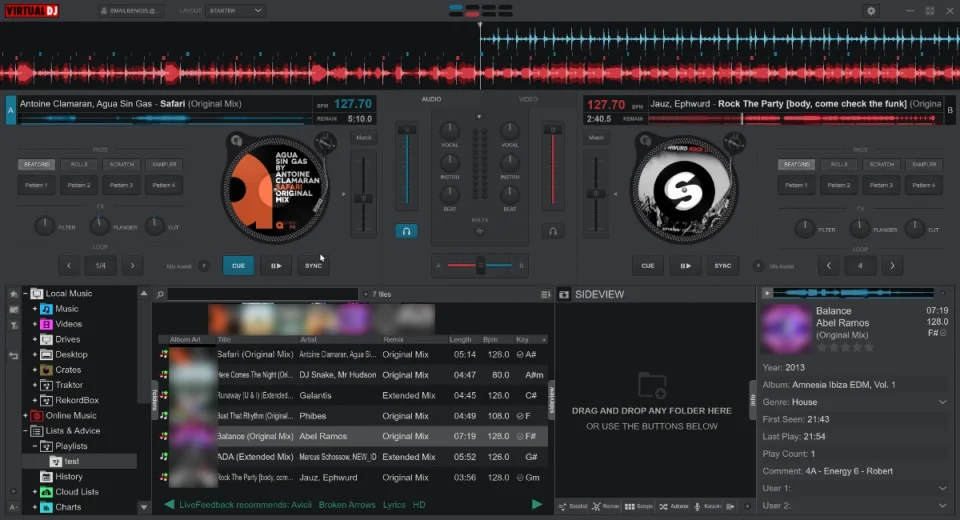
Virtual DJ is the software that probably every DJ looked at when they started out, certainly I have.
Virtual DJ is the software that is known to “work with everything”.
From controllers to other software.
But Virtual DJ also an image problem: it is known as cheap software for the bedroom DJ.
Before writing my extensive Virtual DJ review, I thought so too.
But I came around: the software is very user friendly, very powerful, fast and ideal for the beginner DJ.
The software looks really nice and you can even choose your own UI in the options screen.
I have to give props to the visual album art that is spinning and the arm that is moving towards the center of the virtual record.
The software supports stem separations on existing tracks (separating kick from vocal and drum), but it just doesn’t sound good.
The old fashioned EQ mixing (which you can luckily switch to) sounds much better.
I also miss an easy Camelot or Open key notation in the standard mode, for easy harmonic mixing.
But it shows the steps in key difference between tracks, which I haven’t seen in a lot of software.
You can easily match the key and BPM with the click of a button.
Virtual DJ supports a slew of streaming services like Tidal, Deezer, iDJ Pool (their own platform), Beat source, Beatport and Soundcloud.
I’m not a fan of streaming DJ music, but a lot of DJs care about it.
Virtual DJ has full cloud storage support with Dropbox, Google Drive, or Microsoft One Drive for your music.
You can use the software for free without a controller in an amature-setting.
You don’t need a controller, but it is very useful.
Read my full Virtual DJ review.
Price: free, $49, $99 or $299 perpetual license – check latest price on Amazon (affiliate link)
Manufacturer: Atomix
Website: virtualdj.com
Download: virtualdj.com/download/index.html
Personal rating: ⭐⭐⭐⭐⭐
| Pros | Cons |
| ✔️ Easy to use | ❌ No Dropbox support |
| ✔️ Nice UI | ❌ Bad quality of stems |
| ✔️ One time purchase | ❌ VDJ’s image problem |
| ✔️ Tons of skins | ❌ Partial dual display support |
| ✔️ Wide controller support | |
| ✔️ 1 sec startup | |
| ✔️ Light on system resources | |
| ✔️ Reads Rekordbox, Serato & Traktor libs | |
| ✔️ Extensive streaming support |
#2. Serato DJ
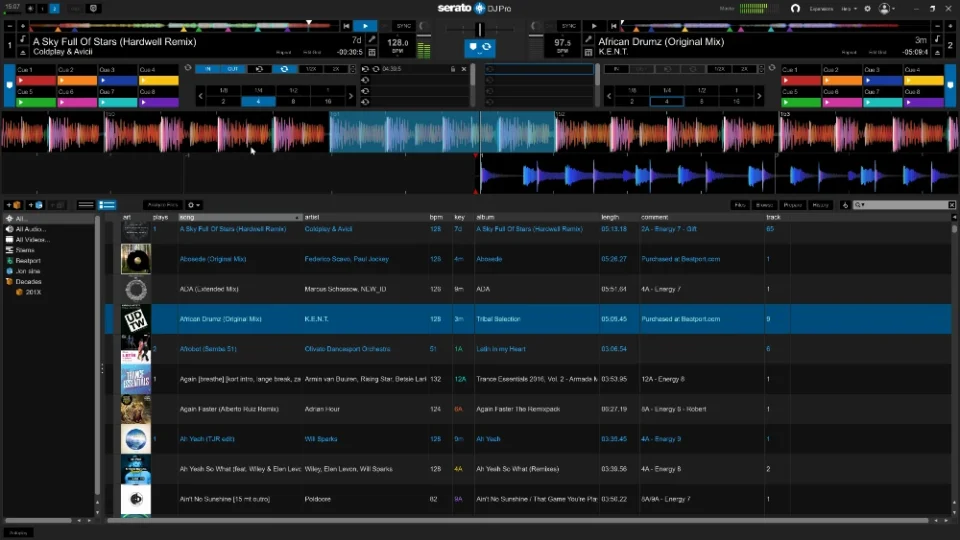
Serato DJ Pro has an OK user interface, but nothing to write home about.
There is a free version available (lite) which looks completely different.
The User Interface buttons are quite small.
This is software you need to operate in a crowded club with sticky mouse surfaces, a big hit-box would make things a lot nicer.
Serato supports stem separation (vocal separated from instrumental), it would be a cool feature if you could actually use it: it sounds very bad.
Also, the instrumental sometimes ‘bleeds’ through the vocal.
I wouldn’t feel comfortable using this in a club.
Serato is a real memory hog. When you choose Serato, make sure you have a enough memory.
I’ve seen it use 5GB without any hesitance.
The beatgrid of tracks is very often wrong.
I say often, but literally every track I loaded into Serato was wrong.
Some tracks where completely wrong for-no-reason, others were shifted ever so slightly back in time.
Meaning that cue points (it sets automatically) and loops you can set, are also set incorrectly by default.
I’ve tested the same tracks in Traktor, Rekordbox and Virtual DJ, they were analyzed correctly.

Using the software with a controller unlocks some extra features (like stem separation for drums).
It also changes the UI a bit.
There are 3 versions: Lite (free), Pro and Suite.
Suite includes essential features like EQ mixing, effects, tempo sync (time stretching), key sync
DVS and video and nice extra’s in the Suite-version.
Read my full Serato Review.
Read my full Rekordbox vs Serato comparison.
Price: free, $10/m, $15/m, $250 perpetual license – check latest price on Amazon (affiliate link)
Manufacturer: Serato
Website: serato.com
Download: serato.com/dj/pro/downloads
Personal rating: ⭐⭐
| Pros | Cons |
| ✔️ wide controller support | ❌ Small buttons |
| ✔️ automatic Hot Cues | ❌ Beatgrid often wrong |
| ✔️ drag BPM up/down | ❌ CPU, GPU, memory intensive |
| ✔️ streaming support | ❌ SSLLOOOWWWWW |
| ❌ No cue button | |
| ❌ No cloud storage support | |
| ❌ Expensive | |
| ❌ No metronome when editing beatgrid |
Free DJ tips in your inbox?
As a bonus gift I will send you a FREE E-book on how to kick-off your DJ career!
#1. Rekordbox
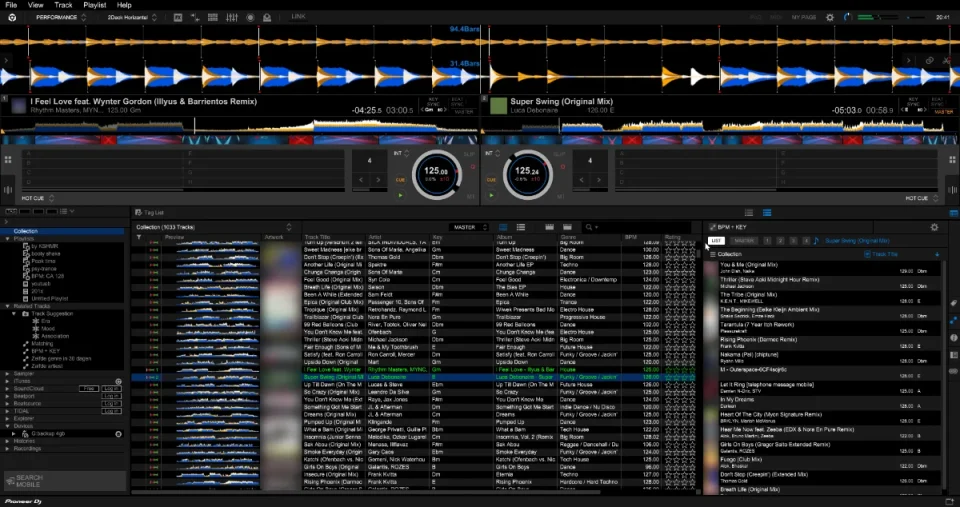
Rekordbox is where it all begins, because AlphaTheta is the industry leader in DJ equipment.
Look at any random club, 90% chance you will find AlphaTheta equipment, which is … powered by Rekordbox.
Rekordbox let’s you prepare and organize your tracks to CDJs (export mode) and also perform (performance mode).
Overall Rekordbox feels kind of slow and sluggish, especially compared to other software out there.
I’ve put that to the test, and indeed, Rekordbox uses a lot of memory and CPU compared to the rest.
Later in this article I’ve included a handy performance comparison table.
The UI in Rekordbox is cluttered and crowded with very tiny buttons
But in return, there is nothing more compatible with DJ hardware than Rekordbox!
You can manage and use the same library for your DJ controller to play at your friends birthday, but also export it to USB to use it on a professional DJ player in a club.
There are 3 versions:
1. free version which is extensive enough to be useful DJ software
2. hardware unlocked version – unlocks some features like the ability to record your mix
3. monthly subscriptions – for features like Syncing with Dropbox and Google Drive
Read my full Rekordbox Review.
Read my full Rekordbox vs Serato comparison.
Price: free (payed subscription for expansions)
Manufacturer: AlphaTheta (aka: Pioneer DJ)
Website: rekordbox.com
Download: rekordbox.com/en/download
Personal rating: ⭐⭐⭐
| Pros | Cons |
| ✔️ Widely supported | ❌ SLLLOOOOWWWW |
| ✔️ Dropbox, Google Drive | ❌ Tiny buttons |
| ✔️ Tidal, Soundcloud, Beatport, Beatsource | ❌ monthly subscription |
| ❌ cluttered UI |
Honorable mentions
Engine DJ
Just like Pioneer has Rekordbox for managing your music library, Denon has Engine DJ.
But Engine DJ is preparation music-library-management ONLY, so you can’t perform with Engine (like you can with Rekordbox).
Nevertheless, I like the software very much.
Engine has a very clean interface with big buttons that are easy to click.
On top of that, it is super fast.
It has Dropbox support.
And you can import your library from iTunes, Serato DJ, Traktor and Rekordbox.
Read my full Engine DJ Review.
Price: free
| Pros | Cons |
| ✔️ Dropbox support | ❌ library management only |
| ✔️ big buttons | ❌ minimal hardware support |
| ✔️ clean UI | |
| ✔️ fast | |
| ✔️ Tidal, Soundcloud, Beatport, Beatsource |
Ableton Live
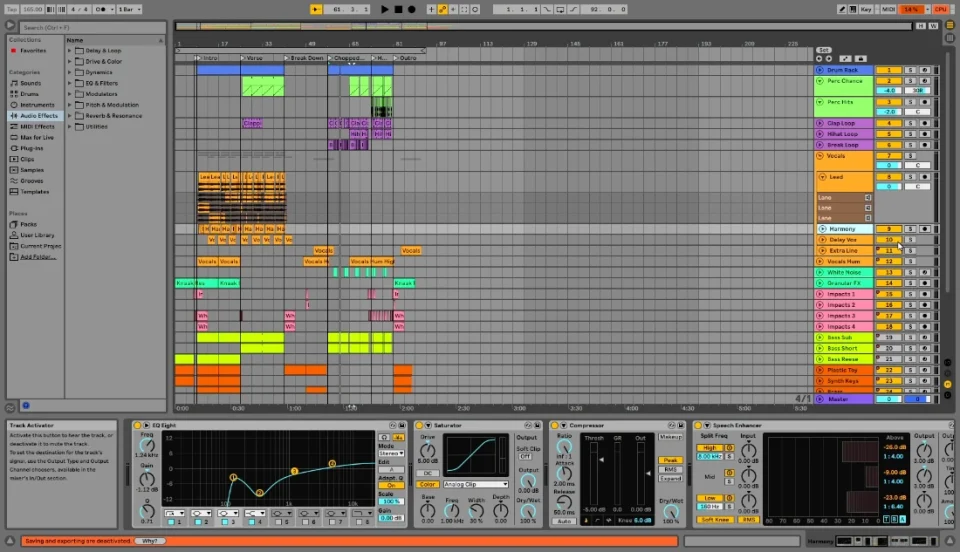
Ableton Live is not your typical run-of-the-mill DJ software, because it is technically live-performance-software/music production software.
You don’t mix the newest track Martin Garrix into the Laidback Luke’s very easily on-the-fly with Ableton.
In the live-section of Ableton Live you create a track on-the-fly with samples and loops.
The focus is on track-creation rather than letting Track A flowing seamlessly into Track B.
Ableton is amazing software for music producers, but not a convenient one for DJs.
It has tons of features you will never use, a 100% overkill for DJs.
DJ.Studio
To be honest, I didn’t dare to install this one on my computer at first, because they are always on the first page with the most spammy half-truth articles in which their software always ranks first.
(sure, and I’m santa clause …. )
Which doesn’t instil me with a lot of confidence.
Asking around, the software seems legit.
If the screenshots are real, I gather it is not really DJ software in the traditional sense.
It is a simple DAW (Digital Audio Workstation) to mix tracks together.
It’s not meant to be software to mix live (linear) environment, but rather a non-linear audio audio editor.
It’s on my TODO-list to review
PCDJ Dex3
One of my subscribers pointed me to PCDJ Dex3, which I never had heard of.
It’s on my TODO-list to review.
Best DJ software for beginners
When you would ask me for the best software for beginners, I would give you a different top 5:
- Virtual DJ – it is just THAT easy and THAT good.
And it’s fast. And free when not using a controller. - DJay pro – I really like the software. Really good for beginners.
The downside is the subscription - Rekordbox – It’s not here because it is easy to learn or the software is good.
It’s on this list because it is industry standard you can grow with the software.
So start with Rekordbox, and you’ll never need anything else. - Traktor – Besides the annoying panels, it is fairly easy to use as a beginner.
- Serato – I don’t know why people rave about the software, I don’t think it is good for beginners.
Features compared
Top 4
RB = Rekordbox (=free)
RB$ = Rekordbox subscription
SRP = Serato Pro (without controller)
SRPC = Serato Pro with controller
SRS = Serato Suite
TRA = Traktor DJ (=free)
TRA$ = Traktor Pro
VDJ = Virtual DJ (=free)
VDJ$ = Virtual DJ payed
| RB | RB$ | SRP | SRPC | SRS | TRA | TRA$ | VDJ | VDJ$ | |
| Perform / Library man. | PL | PL | PL | PL | PL | PL | PL | PL | PL |
| EQ mixing (controller) | ✔️ | ✔️ | ✔️ | ✔️ | ✔️ | ✔️ | ✔️ | ✔️ | |
| EQ mixing (screen) | ✔️ | ✔️ | ❌ | ✔️ | ✔️ | ✔️ | ✔️ | ✔️ | |
| BPM/Grid/Key detect | ✔️ | ✔️ | ✔️ | ✔️ | ✔️ | ✔️ | ✔️ | ✔️ | |
| Phrase detect | ✔️ | ✔️ | ❌ | ❌ | ❌ | ❌ | ❌ | ❌ | |
| Tempo Sync / time-stretch | ✔️ | ✔️ | ✔️ | ✔️ | ✔️ | ✔️ | ✔️ | ✔️ | |
| Key Sync | ✔️ | ✔️ | ❌ | ❌ | ✔️ | ✔️ | ✔️ | ✔️ | |
| Key lock / Master Tempo | ✔️ | ✔️ | ✔️ | ✔️ | |||||
| Active loop | ✔️ | ✔️ | ❌ | ❌ | ❌ | ✔️ | ✔️ | ✔️ | |
| Auto stem separation | ❌ | ✔️ | ✔️ | ✔️ | ✔️ | ❌ | ❌ | ✔️ | ✔️ |
| Play stem tracks | ❌ | ❌ | ❌ | ❌ | ❌ | ❌ | ✔️ | ❌ | ❌ |
| Quantize | ✔️ | ✔️ | ✔️ | ✔️ | ✔️ | ✔️ | ✔️ | ✔️ | |
| Slip/flux mode | ✔️ | ✔️ | ❌ | ✔️ | ✔️ | ✔️ | ✔️ | ✔️ | |
| Beat jump | ✔️ | ✔️ | ✔️ | ✔️ | ✔️ | ❌ | ✔️ | ✔️ | ✔️ |
| DVS | ❌ | ✔️ | ❌ | ❌ | ✔️ | ❌ | ✔️ | ✔️ | ✔️ |
| Video | ✔️ | ✔️ | ❌ | ❌ | ✔️ | ❌ | ❌ | ✔️ | |
| Lighting | ❌ | ✔️ | ✔️ | ✔️ | ✔️ | ✔️ | ❌ | ❌ | |
| Album art | ✔️ | ✔️ | ✔️ | ✔️ | ✔️ | ✔️ | ✔️ | ✔️ | |
| Smart playlists | ✔️ | ✔️ | ✔️ | ✔️ | ✔️ | ✔️ | ✔️ | ✔️ | |
| Max player decks | 4 | 4 | 2* | 2* | 2* | 2 | 4 | 4 | 4 |
| Key notation ** | C | C | CO | CO | CO | O | CN | CN | |
| Record mix | ❌ | ✔️ | ✔️ | ✔️ | ✔️ | ✔️ | ✔️ | ✔️ | ✔️ |
| Sampler | ✔️ | ✔️ | ✔️ | ✔️ | ✔️ | ❌ | ✔️ | ✔️ | ✔️ |
| Hot Cues | ✔️ | ✔️ | ✔️ | ✔️ | ✔️ | ✔️ | ✔️ | ✔️ | ✔️ |
| Cue Points | ✔️ | ✔️ | ✔️ | ✔️ | ✔️ | ✔️ | ✔️ | ✔️ | ✔️ |
| Tag list | ✔️ | ✔️ | ❌ | ❌ | ❌ | ❌ | ❌ | ❌ | ❌ |
| Tidal | ✔️ | ✔️ | ✔️ | ✔️ | ✔️ | ❌ | ❌ | ✔️ | ✔️ |
| Soundcloud | ✔️ | ✔️ | ✔️ | ✔️ | ✔️ | ✔️ | ❌ | ✔️ | ✔️ |
| Beatport | ✔️ | ✔️ | ✔️ | ✔️ | ✔️ | ❌ | ✔️ | ✔️ | ✔️ |
| Beatsource | ✔️ | ✔️ | ✔️ | ✔️ | ✔️ | ❌ | ✔️ | ✔️ | ✔️ |
| iDJPool | ❌ | ❌ | ❌ | ❌ | ❌ | ❌ | ❌ | ✔️ | ✔️ |
| Deezer | ❌ | ❌ | ❌ | ❌ | ❌ | ❌ | ❌ | ✔️ | ✔️ |
| Dropbox | ❌ | ✔️ | ❌ | ❌ | ❌ | ❌ | ❌ | ✔️ | ✔️ |
| MS OneDrive | ❌ | ❌ | ❌ | ❌ | ❌ | ❌ | ❌ | ✔️ | ✔️ |
| Google Drive | ❌ | ✔️ | ❌ | ❌ | ❌ | ❌ | ❌ | ❌ | ✔️ |
| .MP3 | ✔️ | ✔️ | ✔️ | ✔️ | ✔️ | ✔️ | ✔️ | ✔️ | |
| .WAV | ✔️ | ✔️ | ✔️ | ✔️ | ✔️ | ✔️ | ✔️ | ✔️ | |
| .AAC/MP4 (M4A) *** | ✔️ | ✔️ | ✔️ | ✔️ | ✔️ | ✔️ | ✔️ | ✔️ | |
| .AIF/.AIFF | ✔️ | ✔️ | ✔️ | ✔️ | ✔️ | ✔️ | ✔️ | ✔️ | |
| .ALAC (M4A) | ✔️ | ✔️ | ✔️ | ✔️ | ✔️ | ❌ | ❌ | ❌ | |
| .FLAC | ✔️ | ✔️ | ✔️ | ✔️ | ✔️ | ✔️ | ✔️ | ✔️ | |
| .OGG | ❌ | ❌ | ✔️ | ✔️ | ✔️ | ✔️ | ✔️ | ✔️ | |
| Audio CD | ❌ | ❌ | ✔️ | ✔️ | ✔️ | ✔️ | ✔️ | ✔️ |
**Camelot or Open key notation (C = camelot, O = Open key, N = Normal/classic)
*** Non-DRM AAC
**** Mac only
The rest
NGDJ = Engine DJ (=free)
DJP = DJay Pro subscription
BDJ = Beatport DJ
DJU = DJuced
DJUC = DJuced w controller
MIX = Mixxx
| NGDJ | DJP | BDJ | DJU | DJUC | MIX | |
| Perform / Library man. | L | PL | PL | PL | PL | PL |
| EQ mixing (controller) | ❌ | ✔️ | ✔️ | ✔️ | ✔️ | ✔️ |
| EQ mixing (screen) | ❌ | ✔️ | ✔️ | ✔️ | ✔️ | ✔️ |
| BPM/Grid/Key detect | ✔️ | ✔️ | ✔️ | ✔️ | ✔️ | ✔️ |
| Phrase detect | ❌ | ❌ | ❌ | ❌ | ❌ | ❌ |
| Tempo Sync / time-stretch | ✔️ | ✔️ | ✔️ | ✔️ | ✔️ | ✔️ |
| Key Sync | ❌ | ✔️ | ❌ | ❌ | ❌ | ❌ |
| Key lock / Master Tempo | ✔️ | ❌ | ✔️ | ✔️ | ✔️ | |
| Active loop | ✔️ | ✔️ | ❌ | ❌ | ❌ | ❌ |
| Auto stem separation | ❌ | ✔️ | ❌ | ✔️ | ✔️ | ❌ |
| Play stem tracks | ❌ | ❌ | ❌ | ❌ | ❌ | ❌ |
| Quantize | ✔️ | ✔️ | ✔️ | ✔️ | ✔️ | ✔️ |
| Slip/flux mode | ❌ | ❌ | ❌ | ✔️ | ✔️ | ✔️ |
| Beat jump | ❌ | ❌ | ❌ | ✔️ | ✔️ | ✔️ |
| DVS | ❌ | ✔️ | ❌ | ❌ | ❌ | ✔️ |
| Video | ❌ | ❌ | ❌ | ❌ | ❌ | ❌ |
| Lighting | ❌ | ❌ | ❌ | ❌ | ❌ | ❌ |
| Album art | ✔️ | ✔️ | ✔️ | ✔️ | ✔️ | ✔️ |
| Smart playlists | ✔️ | ❌ | ❌ | ✔️ | ✔️ | ❌ |
| Max player decks | 2 | 4 | 2 | 2 | 4 | 4 |
| Key notation ** | CO | CO | N | ON | ON | CON |
| Record mix | ❌ | ✔️ | ❌ | ❌ | ✔️ | ✔️ |
| Sampler | ❌ | ❌ | ❌ | ✔️ | ✔️ | ✔️ |
| Hot Cues | ✔️ | ✔️ | ✔️ | ✔️ | ✔️ | ✔️ |
| Cue Points | ✔️ | ✔️ | ✔️ | ✔️ | ✔️ | ✔️ |
| Tag list | ❌ | ❌ | ❌ | ❌ | ❌ | ❌ |
| Tidal | ❌ | ✔️ | ❌ | ✔️ | ✔️ | ❌ |
| Soundcloud | ❌ | ✔️ | ❌ | ✔️ | ✔️ | ❌ |
| Beatport | ❌ | ✔️ | ✔️ | ✔️ | ✔️ | ❌ |
| Beatsource | ❌ | ✔️ | ❌ | ✔️ | ✔️ | ❌ |
| iDJPool | ❌ | ❌ | ❌ | ❌ | ❌ | ❌ |
| Deezer | ❌ | ❌ | ❌ | ❌ | ❌ | ❌ |
| Dropbox | ✔️ | ❌ | ❌ | ❌ | ❌ | ❌ |
| MS OneDrive | ❌ | ❌ | ❌ | ❌ | ❌ | ❌ |
| Google Drive | ❌ | ❌ | ❌ | ❌ | ❌ | ❌ |
| .MP3 | ✔️ | ✔️ | ❌ | ✔️ | ✔️ | ✔️ |
| .WAV | ✔️ | ✔️ | ❌ | ✔️ | ✔️ | ✔️ |
| .AAC/MP4 (M4A) *** | ✔️ | ✔️ | ❌ | ✔️ | ✔️ | ✔️ |
| .AIF/.AIFF | ✔️ | ✔️ | ❌ | ✔️ | ✔️ | ✔️ |
| .ALAC (M4A) | ✔️ | ❌ | ❌ | ❌ | ❌ | ❌ |
| .FLAC | ✔️ | ✔️ | ❌ | ✔️ | ✔️ | ✔️ |
| .OGG | ✔️ | ❌ | ❌ | ✔️ | ✔️ | |
| Audio CD | ❌ | ❌ | ❌ | ❌ | ❌ | ❌ |
**Camelot or Open key notation (C = camelot, O = Open key, N = Normal/classic)
*** Non-DRM AAC
**** Mac only
Performance compared
I’ve looked at the average CPU and memory usage of DJ software.
The tests were done on a freshly rebooted 10gen Intel Core i9 with 64MB of memory, a NVidia RTX 3080 on a Windows PC, and a PCIe-3 NVME SSD.
I’ve taken “peaks”, instead of “constant load” for these numbers:
| software | RAM | RAM Analyze | CPU | CPU Analyze | GPU | Startup | Analyze 1000* |
|---|---|---|---|---|---|---|---|
| Rekordbox | 1300 MB | 1800 MB | 6% | 65% | 12% | 9 sec | 13m 50s |
| Engine DJ | 600 MB | 800 MB | 2% | 46% | 14% | 5 sec | 4m 26s |
| Serato Pro | 5000 MB | 3000 MB | 3% | 96% | 19% | 17 sec | 6m 3s |
| Traktor Pro | 900 MB | 1000 MB | 1% | 26% | 1% | 5 sec | 22m 58s |
| Virtual DJ | 1800 MB | 730 MB | 1% | 40% | 9% | 1 sec | 4m 0s |
| DJay Pro | 2500 MB | ?** | 6% | ?** | 6% | 4 sec | 0m 0s** |
| Beatport DJ | 600 MB | ?*** | 5% | ?*** | 5% | 3 sec | ?*** |
| DJuced | 1300 MB | 1700 MB | 5% | 96% | 20% | 8 sec | 7m 13s |
| Mixxx | 2100 MB | 261 MB | 2% | 11% | 13% | 8 sec | 2m 0s |
* 1000 songs were analyzed (10x AIFF files, 4x WAV files, 986 mp3 files)
Not every software analyzes the same data:
Rekordbox: Key, BPM, beatgrid, phrases
Engine DJ: Key, BPM, beatgrid
Serato: Key, BPM, beatgrid, cue points
Traktor: Key, BPM, beatgrid, gain
Virtual DJ: Key, BPM (additional beatgrid/cuepoint analyzing is going on in the background when loading individual tracks in a deck).
DJay Pro**: nothing (analyzes Key, BPM and beatgrid when loading individual tracks in a deck)
Beatport DJ***: Key, BPM, beatgrid (Can’t import own tracks. Beatport library is pre-analyzed)
Mixxx: Key, BPM, beatgrid, cue points
Concluding that Engine DJ takes up the least amount of resources and on top of that, is the fastest of them all.
I think this is because Engine DJ is a little bit the new kid on the block, was probably programmed from the ground up and has less old code to bloat the program.
Poll results
Here are the results of the poll:
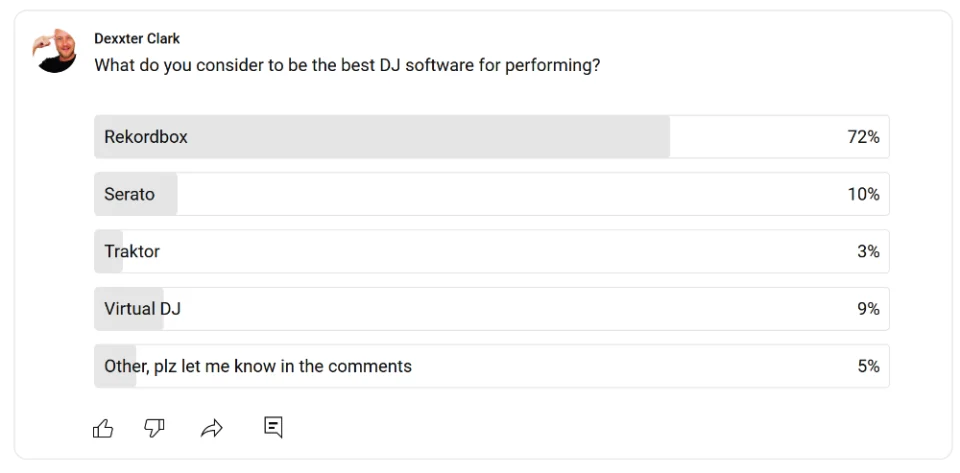
You see that Rekordbox has the vast majority of the votes.
It’s not even a competition compared to the rest, that walks away with just a small percentage of the votes.
Serato and Virtual DJ are very close on the 2nd and 3rd place.
And last but not least Traktor.
Video
Relevant reviews
- Rekordbox review
- Virtual DJ review
- Serato review
- Traktor review
- DJay Pro review
- Beatport DJ review
- DJuced review
All the do’s and dont’s for DJ software, check out my DJ software buying guide:


